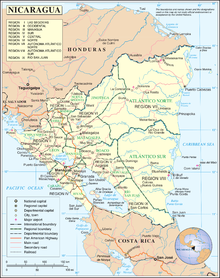Eisenstuck affair
The Eisenstuck Affair 1876–1878 was a diplomatic-military conflict between the German Empire and the Republic of Nicaragua . It was linked to the largest operation the Imperial Navy carried out in Central America at the end of the 19th century . It took place on both the Pacific and the Atlantic coast .

The reason for the intervention were two attacks on the imperial honorary consul Paul Eisenstuck in the city of León in western Nicaragua in 1876. Eisenstuck had lived in Central America for some time and was married there. His stepdaughter was in divorce and the family was attacked twice on the street. During the first attack on October 23, 1876, the son-in-law fired three shots, but they didn't hit. The second attack on November 29, 1876 was much more brutal and was carried out by police soldiers who beat up the consul and arrested him. Although Eisenstuck was released on the way to court because of his diplomatic status , all criminal investigations against the perpetrators came to nothing. The criminal court referred to the path of a private lawsuit and gave the incident the rank of a "family feud" in which the son-in-law merely tried to win back his wife.
Germany demanded that Nicaragua punish the perpetrators, pay compensation of US $ 30,000 as well as a flag salute by Nicaraguan soldiers. Nicaragua did not comply, probably because there were hardly any diplomatic or economic contacts.
During the entire affair, the Federal Foreign Office made sure that Germany behaved in accordance with the applicable norms of international law . Its legal position has been confirmed several times by Great Britain and the USA . In accordance with the diplomatic customs of the time, Germany increased the pressure, but at the same time switched on the United Kingdom and the USA as mediators. The mediation was unsuccessful, especially since the Nicaraguan government treated the US diplomats so brusquely that the US broke off diplomatic relations with Nicaragua until the end of the affair .
The Foreign Office finally asked the Imperial Admiralty for assistance in August 1877. The Admiralty sent the corvettes SMS Leipzig , SMS Ariadne from Germany and the corvette SMS Elisabeth from Japan, which was on a circumnavigation of the world, to the west coast of Panama , where the three ships united to form a squadron on March 9, 1878 under Captain Wilhelm von Wickede sailed to Corinto . Another ship, the cadet training ship SMS Medusa , was on a routine voyage in the West Indies and was ordered to the east coast of Nicaragua. The ships reached their destination on March 17 and 18, 1878. However, the ships were not equipped for landing operations and were therefore hardly able to exert military pressure on the government in the inland capital of Managua .
Even so, the Nicaraguan government gave in on March 31, 1878. She paid US $ 30,000 in damages, the perpetrators were fined (US $ 500), and a detachment of Marines saluted the flags. No shot was fired in the entire conflict.
The affair is an example of gunboat policy by European powers at the time. The young German Reich in particular tried to be taken seriously as a great power. This was due to a desire for national prestige, but it also had a factual background. The treatment of foreign citizens abroad depended very much on the reputation of their home country. The business of German merchants in Latin America also depended on whether the governments there had respect for the German Reich.
Gaining this respect for the Reich was one of the main tasks of the foreign cruisers of the Imperial Navy. The Eisenstuck affair showed that, due to inadequate equipment, it was unable to carry out a real landing operation against a Latin American state. The fact that the operation nevertheless achieved the desired success is due, on the one hand, to the diplomatic skill of the association leader, Wilhelm von Wickede, who is very experienced in Central America, and, on the other hand, to the fact that the German demands on Nicaragua were perceived as very moderate.
The position of the government of Nicaragua is utterly puzzling. Historians speculate that the government hoped the Germans would bombard opposition León , but it did not. The intervention was a heavy burden for long-term German-Nicaraguan relations, and it was not supported by the small German colony of Nicaragua. It was not until 1894 that a trade agreement was concluded which, according to Houwald, “could make people forget” what had happened at the time.
Eisenstuck's stepdaughter later returned to her husband and was married to him until at least 1914.
literature
- Götz von Houwald : Los alemanes in Nicaragua. Managua 1975.
- Hartmut Klüver (Hrsg.): Foreign missions of German warships in peace. Bochum 2003, ISBN 3-89911-007-2 .
- Gerhard Wiechmann: The Prussian-German Navy in Latin America 1866-1914. A study of German gunboat policy . Bremen 2002, ISBN 3-89757-142-0 , urn : nbn: de: gbv: 715-oops-4458
- Gerhard Wiechmann: The Royal Prussian Navy in Latin America 1851 to 1867. An attempt at German gunboat policy . In: Sandra Carreras, Günther Maihold (Hrsg.): Prussia and Latin America. In the field of tension between commerce, power and culture. (Europa-Übersee, Volume 12), Münster 2004, ISBN 3-8258-6306-9 , pp. 105-144.
Individual evidence
- ^ Gerhard Wiechmann: The Royal Prussian Navy in Latin America 1851 to 1867. An attempt at German gunboat policy. in: Sandra Carreras, Günther Maihold (Eds.): Prussia and Latin America. In the field of tension between commerce, power and culture. (Europa-Übersee Vol. 12), Münster 2004, ISBN 3-8258-6306-9 , p. 140.
- ^ Götz von Houwald: Los alemanes en Nicaragua. Managua 1975, p. 130.

